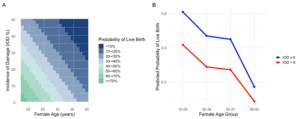While conventional semen analysis has been the standard since the 1950s, it often fails to provide a complete picture of male fertility. In fact, a semen analysis provides no explanation for infertility in 25-30% of couples, who are then diagnosed with “unexplained” infertility.
In contrast, sperm DNA fragmentation (SDF) has been identified as a robust and powerful biomarker for male infertility, failed fertility treatments, and miscarriage.
Research Findings
Sperm DNA Fragmentation & Infertility
A standard semen analysis simply measures the quantity and movement of sperm. It does not assess the quality of the genetic material inside the sperm, which is vital for fertilisation, embryo development, and implantation.
Examen research has shown that sperm from fertile men have low levels of DNA fragmentation compared to sperm from infertile men (Figures 1 and 2).


Scientific References – SDF & Infertility
Sperm DNA Fragmentation & IVF
Based on Examen research, increased levels of double-stranded DNA fragmentation, as determined by the Extend test, result in a lower likelihood of a live birth outcome following IVF treatment (Figure 3a &b).
This probability also had a strong correlation with female age, showing that both double-stranded DNA damage and female age are important factors in successful IVF treatment.
This highlights the importance of SDF testing in helping you and your patient choose the most effective treatment path.

Scientific References – SDF & Fertility Treatment Success
- A systematic review and meta‐analysis to determine the effect of sperm DNA damage on in vitro fertilization and intracytoplasmic sperm injection outcome
- Double-Stranded Sperm DNA Fragmentation measured with Neutral Comet Assay as a Predictor of IVF Outcomes: Evidence from Three European Clinics in a Multi-Centred Prospective Study
- Sperm DNA damage has a negative association with live-birth rates after IVF
Sperm DNA Fragmentation & Recurrent Miscarriage
Recurrent Miscarriage affects 1-2% of couples attempting to conceive and represents a significant worry for couples.
Examen research has shown that increased levels of double-stranded DNA fragmentation, as determined by the Extend test, were strongly associated with recurrent miscarriage (Figure 4), showing that sperm DNA quality is a factor in recurrent miscarriage.

Scientific References – SDF & Recurrent Miscarriage
- Sperm DNA fragmentation is a novel biomarker for early pregnancy loss
- Sperm DNA fragmentation in Italian couples with recurrent pregnancy loss
- The effect of sperm DNA fragmentation on miscarriage rates: a systematic review and meta-analysis
- Double-stranded sperm DNA fragmentation assessed using comet assay is associated with recurrent pregnancy loss
- Double Stranded Sperm DNA Breaks, Measured by Comet Assay, Are Associated with Unexplained Recurrent Miscarriage in Couples without a Female Factor



